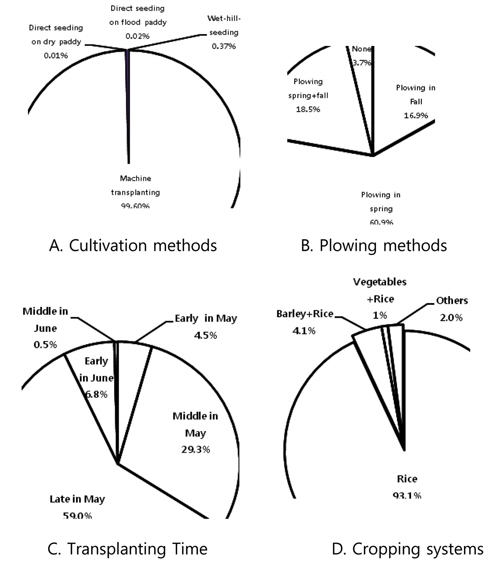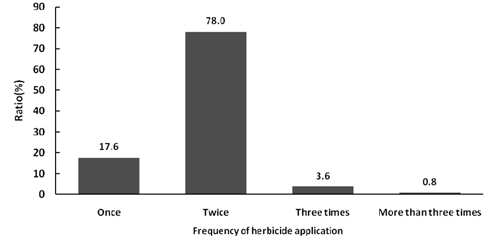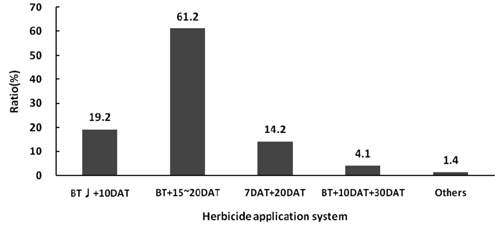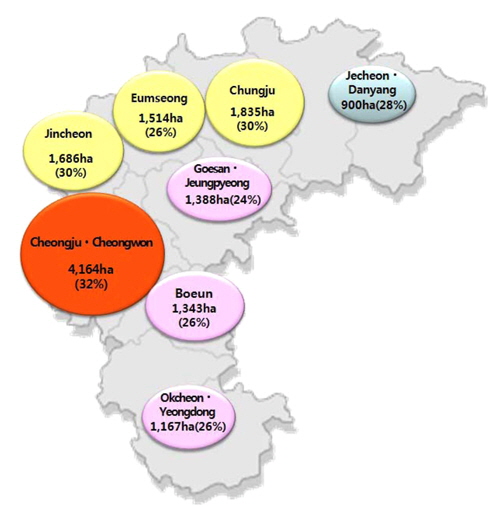



Studies were carried out to provide basic information for establishing the weed control in Chungbuk, Korea. The present surveys targeting 260 farmers in Chungbuk province were conducted for the cultivation system, weeds occurrence and usage of herbicides. To estimate the occurring area of herbicide resistant weeds, soil samples from 400 paddy fields were collected twice on August, 2011 and April, 2012. In the results of survey, the 99.6% of farmers used the rice planting machine and the 78% of the farmers disseminated herbicides twice to control weeds before and after planting rice. The most commonly used herbicide were as follows; soil-applied herbicide : butachlor 46.6%, mid-term herbicide : mefenacet + pyrazosulfuron-ethyl 10.7%, foliar herbicides : bentazone 62%. The dominant paddy field weeds included
저항성잡초는 전 세계적으로 211초종(124 dicots and 87 monocots)에 393개의 저항성 생태형이 약 690,000개 이상 경작지에 발생되는 것으로 보고되고 있다(Heap, 2012). 현 재까지 국내 제초제 저항성잡초는 물옥잠(
우리나라 논의 저항성잡초는 1990년 초부터 약효 지속 성이 매우 길고 잡초의 생장점에서 효소만 억제하여 살초 하는 SU계 제초제가 광범위하게 등록되어 연용 되면서 저 항성잡초 발생면적이 급증하였으며(Park, 2011), 이들 SU 계 제초제들은 광엽잡초와 방동사니과 잡초에도 방제효과 가 우수하여 농촌의 노동력이 부족한 현실 때문에 저항성 잡초 발생이 증가함에도 불구하고 사용량이 계속 증가하 여 95%까지 사용되고 있다(Park et al., 2011). 벼 기계이 앙 논에서 SU계 저항성잡초를 방제하지 못할 경우 벼 수량이 물달개비 발생시에는 44%까지 감소되고(Kwon et al., 2002), 저항성 피의 경우 밀도가 m2당 5본 이상일 때 쌀 수량이 10%이상 감소된다(Lee et al., 2006). 이러한 피해 를 막기 위해서 현재 저항성잡초를 효과적으로 방제할 수 있는 새로운 약제 개발과 3개 이상의 약제를 혼합한 혼합제 개발에 대한 연구가 계속되고 있다(Lee et al., 2011; Park et al., 2010).
저항성잡초를 효과적으로 관리하기 위해서는 같은 작용 기작을 가진 제초제 연용을 피하고, 작물의 재배시기 별로 또는 해마다 다른 약제를 번갈아 처리해야 하며, 파종 시기, 재배방법, 발생잡초 초종에 따라 작용기작이 다른 제초제를 선정하여 체계처리를 하여야 방제할 수 있다(Koo and Kim, 2003). 그러나 충북 지역의 경우 벼 재배 농업 인들의 농약사용 실태 및 저항성잡초 발생 현황에 대한 조사 결과가 없어 저항성잡초 방제체계 확립에 어려움이 있다.
본 연구는 충북지역 벼 재배 농업인들을 대상으로 논에 발생하는 잡초의 발생실태와 사용약제들을 조사하고, 저항성잡초 발생 지역 및 일반농가의 논토양을 조사하여 SU 계 제초제 저항성잡초의 발생면적을 예측함으로써 충북지 역 제초제 저항성잡초방제를 위한 새로운 방제법 개발과 제초제 저항성 발생 피해를 사전에 예방하고자 수행하였다.
충북지역 벼 재배농가를 대상으로 재배양식, 제초제 사용현황, 주요 발생잡초, 제초제 저항성잡초 초종 등의 항목에 관하여 설문조사를 실시하였다. 조사지역(인원)은 청 주시(30명), 충주시(25명), 제천시(10명), 청원군(30), 음성 군(30), 진천군(20), 괴산군(30), 증평군(20), 보은군(20), 옥 천군(30), 영동군(10), 단양군(5) 등 12개 지역 260명이었 다. 조사결과는 SPSS (Statistic Package for Social Sciences) 프로그램을 이용하여 빈도분석하였다.
지역별 제초제 저항성잡초 발생면적을 파악하기 위해 2011년 8월과 2012년 4월에 일반농가 포장을 임의로 선정하여 논토양을 채취하였다. 조사지점은 충북지역을 8개 권역으로 나누어 총 400점의 논토양을 채취하였는데 청주·청원(50), 충주(50점), 제천·단양(50점), 음성(50점), 진천(50점), 괴산·증평(50점), 보은(50점), 옥천·영동(50 점)에서 채취하였다. 토양 채취 방법은 지점별로 2~3 kg 정 도의 논흙을 채취하기 위하여, 3~4군데의 0~5 cm이내의 표 토를 채취 한 후 혼합하였다. 채취 토양은 온실 내에서 60×40×10 cm의 사각 포트에 넣어 논과 같은 담수조건을 만들어 주었고, 15일 후에 SU계 제초제인 피라조설퓨론 에틸 +피리미노박메틸입제를 30 kg/ha로 처리하였다. 약제 처리 후 20일에 생존한 잡초를 조사하여 저항성잡초 발생 면적으로 환산하였다.
충북지역 벼 재배농가의 재배양식 및 작부체계 등에 대 한 설문조사 결과(Fig. 1), 재배방법은 기계이앙이 99.6%로 대부분을 차지하였고, 무논점파가 0.37%인 180 ha 정도, 건 답직파 및 담수직파는 0.03%인 15 ha정도로 미미한 수준이 었다(Fig. 1A). 경운 시기는 춘경이 60.9%로 가장 많았고, 추경이 16.9%, 춘경과 추경을 동시에 하는 농가는 18.5% 였으며, 경운을 하진 않는 농가도 3.7%를 차지하였다(Fig. 1B). 충북지역의 벼 이앙시기는 5월 하순이 59%로 가장 많았으며, 5월 초순~하순까지 92.8%의 농가에서 이앙을 마치는 것으로 나타났다(Fig. 1C). 충북 벼 재배농가의 작 부체계는 93.1%가 벼 일모작, 맥류 후작 재배는 4.1%, 과 채류와 벼 재배의 경우 1.0%, 기타 2.0%로 대부분 농가 에서 일모작을 하고 있었다(Fig. 1D).
충북지역 벼 재배농가의 잡초방제 실태에 대한 설문조사 결과(Fig. 2), 제초제 사용횟수는 2회 사용하는 농가가 78.0%로 가장 많았고, 한 번 사용하는 농가는 17.6%였으며, 3번 이상 제초제를 처리하는 농가는 4.4%로 조사되다. 이런 결과에서 농가에서는 제초제 체계 처리를 실시하는 것으로 보여지나, 일부는 무분별하게 사용하여 환경에 부담이 될 수 있을 것으로 사료 된다.
제초제를 1회 사용한 농가의 제초제 사용시기는 Fig. 3과 같다. 이앙 후 10일 이내에 사용하는 농가가 39.2%, 써 레질직후에 사용하는 농가가 33.9%, 이앙 후 10~15일 후에 시용하는 농가는 18.5%로 나타났고, 경엽처리 제초제를 사용하는 농가는 8.4%로 나타났다. 이는 잡초발아 전토양처리제로써 써레질 할 때 제초제를 살포하는 것이 이상적이나(Lee et al., 1998), 일손부족으로 적기 제초제 처리가 어려워 잡초 발생상황을 지켜본 후 제초제를 시용하는 것으로 보인다.
제초제를 2번 이상 사용하는 농가의 제초제 사용방법을 조사한 결과(Fig. 4) 이앙 전 써레질 직후에 1회 사용한 후 이앙 후 15~20일 이내에 2차 처리하는 농가가 61.2% 로 가장 많았으며, 그 다음으로는 이앙 전 써레질 직후에 1차 처리하고, 이앙 후 10일 이내에 2차 처리하는 농가가 19.2%였다. 써레질 직후와 이앙 후 10~15일 이내 그리고 경엽 처리까지 체계처리를 하고 있는 농가는 4.1% 로 나타났다. Lee et al. (1998)의 조사 결과 때보다 2회 처리 농가의 비율이 32%나 증가되어 농가에서도 체계처리 방향으로 많이 전환된 것으로 판단되었다.
충북지역 논잡초 방제를 위한 제초제 사용실태를 분석해 보면(Table 1), 초기 제초제는 48.3%의 농가에서 사용하였고, 사용 약제별로는 butachlor 사용량이 46.6%로 가장 많았으며, 그 뒤로 oxadiazon이 27.7%로 두 약제가 74.3% 의 높은 사용량을 나타내었다. 그 외에 pentoxazone이 5.9%, oxidiargyl이 5%로 나타났으며, benzobicyclon이 함유된 제초제의 경우 9.2% 정도 살포되는 것으로 조사되었다. 초기 제초제 선호도는 가격이 타제품보다 비교적 저렴한 butachlor 입제 등을 많이 선호하였다는 결과(Kim et al., 1997; Lee et al., 1998)와 같았다.
[Table 1.] List of preferred herbicides on farmer's level in Chungbuk.
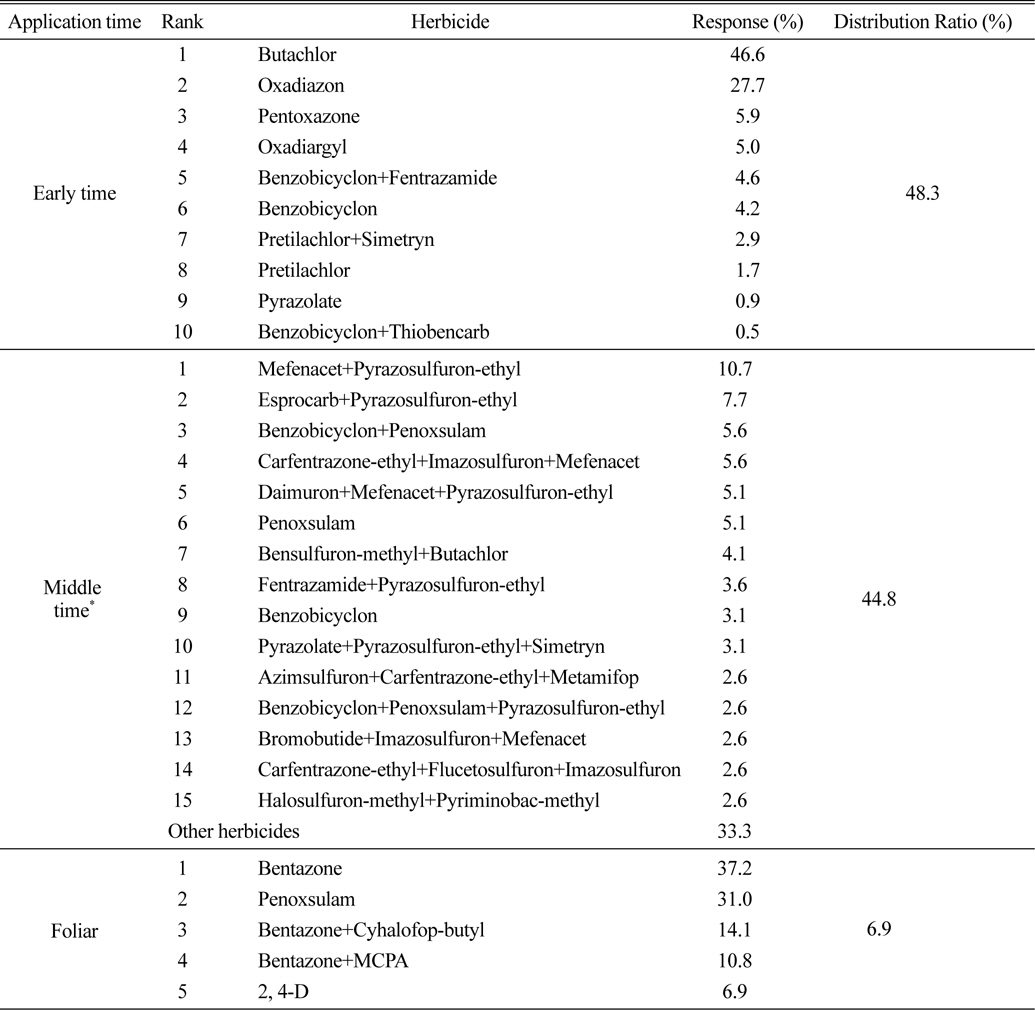
List of preferred herbicides on farmer's level in Chungbuk.
중기제초제의 종류는 49종으로 다양하였고, 약제별 사용량은 mefenacet + pyrazosulfurone-ethyl이 10.7%로 가장 높았고, 그 뒤로 esprocarb + pyrazosulfuron-ethyl이 7.7% 였다. 충북지역에서 사용되는 중기 제초제 중 SU계 제초제는 80.6%로 나타났으며, benzobicyclon계 제초제의 사용량이 20%를 넘는 것으로 나타났다. 또한 thiobencarb과 같은 단제의 사용량은 2% 미만이었고, 모두 2가지 이상의 혼합제를 사용하고 있었으며, 이 중 3종 혼합제제는 47.1%이었다. 이런 결과는 SU계 제초제와 화본과 전용 제초제 혼합제형의 “일발처리제” 제초제들이 주로 사용되면서 저항성잡초 문제가 더욱 심각해짐에 따라 3종 이상의 약제들의 개발이 이상적이라는 보고(Park, 2008) 내용과 같은 방향으로 제초제가 사용 되어지는 것으로 보인다. 경엽처리 제초제의 사용 비율은 6.9%로 매우 낮았으며 사용 제초제의 종류도 bentazone 등 5종류로 많지 않았고, 약제도 bentazone 단제 및 혼합제가 62%를 차지하였고, 그 뒤로 penoxsulam이 31%를 차지하였다.
충북지방에서 주로 발생되는 논잡초에 대한 설문조사 결과(Table 2), 피가 16.2%로 가장 우점하는 것으로 나타났다. 이 결과는 Lee et al. (1998)의 전국 설문조사, Kim et al. (2012)의 경상북도 지역의 우점잡초 조사 결과와 동일하였으나, 그 뒤로 올챙이고랭이가 12.2%, 물달개비가 11.9%, 벗풀 9.5%, 올미 8.4%, 가막사리 7.4% 순으로 분포되어, 전체적인 잡초 군락 분포는 2012년에 조사된 경북과 강원지역의 조사결과(Kim et al., 2012; Seo et al.,2012)와는 다른 경향이었다. 이와 같이 논잡초 군락이 지역별로 차이가 있는 원인은 지역별로 다른 제초제를 연용하는데 원인이 있는 것으로 보여진다. 또한 SU계 혼합제초제 사용량 증가에 따라 방제효과가 낮은 다년생잡초의 우점도가 높아지고(Park et al., 1995), ACCase 및 ALS 저해 제초제에 대한 저항성 피의 발생량이 증가된 것이 원인(Park et al., 2010)으로 보여진다. 논에 발생하는 잡초중 방제가 어려운 잡초 초종에 대한 조사 결과(Table 3), 올챙이고랭이가 20.0%, 물달개비가 19.2%, 벗풀 12.8%, 피 12.2%, 올미 10.7% 순으로 총 12초종이 저항성잡초로 의심 된다고 하였다.
[Table 2.] Lank of dominant weeds at paddy rice field in Chungbuk, Korea.
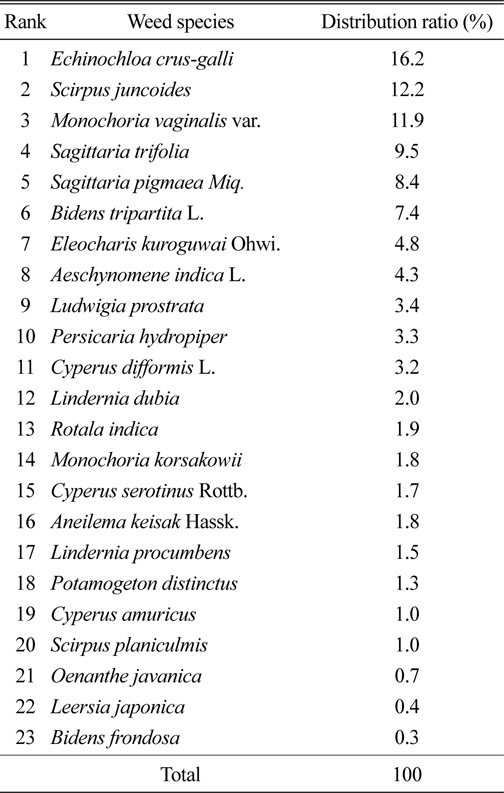
Lank of dominant weeds at paddy rice field in Chungbuk, Korea.
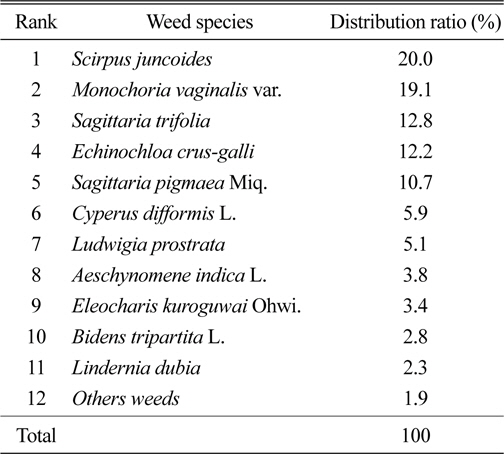
Rank of resistant weed species assumed from surveyed farmer's responses in Chungbuk, Korea.
충북 지역별 제초제 저항성잡초 발생면적을 조사하기 위해 충북지역을 총 8개 권역으로 나누어 토양시료를 채취하여 제초제 저항성잡초 발생면적을 2011년과 2012년 2년간 조사한 결과(Table 4), 충북지역의 제초제 저항성잡초 발생면적은 2011년 9월 조사에서는 충북지역 논 면적의 25.7%인 12,650 ha, 2012년 4월 조사에서는 논 재배면적의 27.8%인 13,684 ha로 확인되었다. 2년 동안 조사한 결과를 평균하면 충북지역 논 재배면적의 26.8%인 13,167 ha에서 SU계 제초제 저항성잡초가 발생되는 것으로 확인 되었다. 2008년까지 국내 저항성잡초 발생면적은 107,000 ha정도였는데(Park et al., 2011), 2012년 조사에서는 제초제저항성잡초 발생면적이 167,081 ha (Lee et al., 2012)로 5년 만에 60,081 ha가 늘어났다. 이상의 결과와 같이 충북지역의 제초제 저항성잡초도 빠르게 면적이 확대되고 있을 것으로 사료된다.

Estimated occurrence area of herbicide resistant paddy weeds assumed from 400 paddy field samples in Chungbuk, Korea.
충북의 시군별 발생면적을 보면(Fig. 5), 충북지역 논 면적 중 가장 많은 비중인 26%를 차지하는 청주청원지역이 제초제 저항성잡초 발생비율도 가장 높은 32%, 4,164 ha로 확인되었고, 충주 1,835 ha(30%), 진천 1,686 ha(30%), 음성 1,514 ha(26%), 괴산·증평 1,387 ha(24%) 순이었다. 제천·단양지역은 900 ha(28%)로 상대적으로 낮았고, 괴산·증평 지역이 24%로 가장 발생비율이 적었다.
제초제 저항성잡초 초종별 발생면적은(Table 5) 2011년에는 물달개비 36.4%, 올챙이고랭이 30.7%, 미국외풀 10.6%,피 9.5%, 여뀌바늘 2.7%, 알방동사니 1.0%의 순으로 나타났으나, 2012년에는 올미, 올방개, 마디꽃, 벗풀, 가막사리가 추가되었다. Lee et al. (2012)의 결과 피, 미국외풀, 올미, 마디꽃 등이 충북지역에서도 점차 확산되는 경향과 동일하였다.
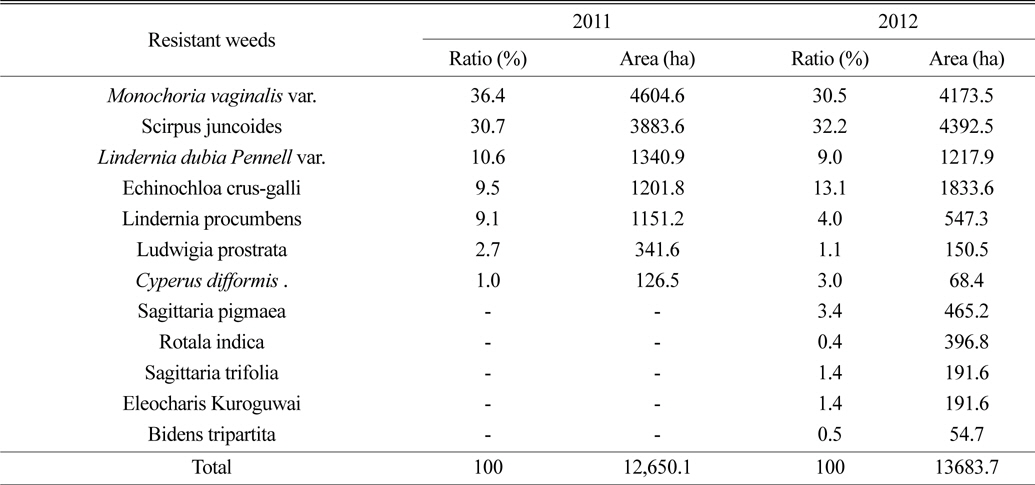
Occurrence area of sulfonylurea herbicide resistant weeds species in rice paddy filed of Chungbuk, Korea.
2년 동안 제초제 저항성 논잡초 조사결과 올챙이고랭이와 물달개비의 발생면적이 충북지역 논면적의 30% 이상에서 발생되었다. 우리나라는 SU계 제초제들과 molinate가 혼합된 “일발처리제”들이 선호되어 종자 생산량이 상대적으로 월등한 물달개비가 우점하였고, 일본에서는 mefenacet가 혼합된 “일발처리제”가 광범위하게 사용되어 방제효과가 낮은 올챙이고랭이가 상대적으로 우점한다(Park et al., 2011)는 연구결과와 달리 두 초종 모두 우점 하였다(Table 1). 저항성 피 발생면적도 2011년의 9.5%에서 2012년에는 13.1%로 발생면적이 넓어졌다. 물달개비, 올챙이고랭이, 알방동사니 등은 benzobicyclone, carfentrazone, pyrazolate 등의 약제로 방제 가능하나, 피의 경우에는 ACCase 및 ALS 저해제에 저항성을 나타낼 경우 벼 직파재배에서는 대체약제가 없고, 이앙재배에서도 제초제 사용시기가 10일 이내로 제한적일 수밖에 없으므로(Park et al., 2011), 저항성 피 방제 체계 수립 및 약제 개발이 필요할 것으로 생각되었다.
